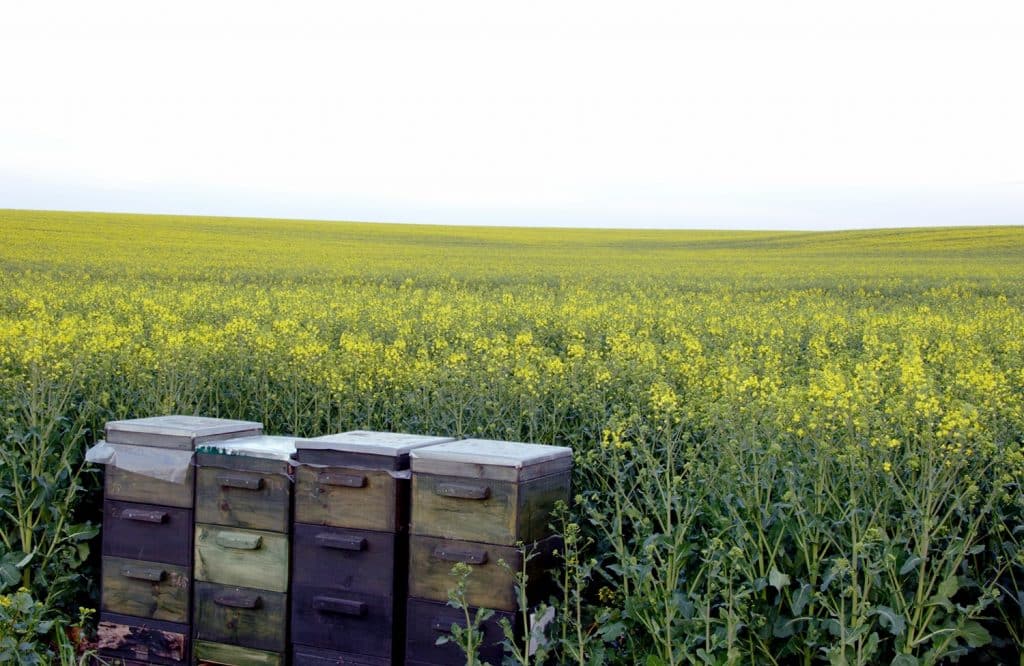Bees love canola, and canola loves bees
It makes sense that the Prairies are Canada’s main production region for both canola and honey. Simply put, canola is good for bees, and bees are good for canola. Together, they are good for the health of our agroecosystem and our economy.
Learn more about
Canola and bees: a sweet relationship
Beekeepers seek out canola fields because they are such a good nectar/pollen source, and canola growers know it’s in their best interest to protect nearby pollinators. Honey producers and canola growers work together to help both industries thrive.
As canola production in Canada grew to all-time highs, the number of honey bee colonies in Canada also reached near-record levels.
Why bees love canola
Bees prefer canola to other flowering plants because they like the colour and scent. Yellow is one of the most attractive colours to a honey bee, and the fluorescent anthers make canola blooms particularly enticing.
Even the size and shape of canola flowers are just right for bees. The petals are a convenient landing platform, and the reservoirs of nectar are located at just the right length for a honey bee proboscis.
Why canola loves bees
Research suggests pollination can encourage higher yields and better ripening. A study in Australia showed that canola pods/plant decreased as distance from an apiary increased. 1
Why the honey industry loves canola

Canola provides an abundant supply of pollen with an ideal mix of amino acids, protein and fats for bees. The plentiful nectar has a good sugar profile for honey production.
This nutritional balance helps bees produce excellent honey. The light colour and mild flavour make canola honey a top choice in the marketplace.
Because the blooms are so plentiful, bees can feed efficiently on canola without traveling far. Canola flowers longer than most other crops, and one field in bloom can nourish bees for up to a month.
Bee health near canola fields
In the past decade, the number of honey bees in Canada has reached record levels. More than 70 per cent of these colonies are in Western Canada, where canola has become one of the most important crops.
The health of hives remains high as these two industries grow in close proximity. The overwhelming majority of beekeepers have reported no problems with canola production practices. Seed treatments used for canola do not put pollinators at risk because treatments remain on the seed and are not released as dust into the air. Field studies show no chronic or acute poisonings from seed treatments when analyzed at field scale rates. 2
The mysterious U.S. problem known as colony collapse disorder has not been observed in Canada – nor has it been seen in Australia, the world’s other major canola-producing region. In Western Canada, bees are most commonly killed by natural forces such as harsh winters, starvation from lack of access to quality food sources or biological factors such as Varroa mites and diseases like nosema cerranae and American foulbrood.
Working together to promote bee health
The Canola Council of Canada promotes bee protection in co-operation with the Canadian Honey Council and the Honey Bee Health Coalition. Together, we ensure canola production practices are compatible with pollinator health.
The Canola Council encourages farmers and aerial applicators to talk to nearby honey producers about pest management plans, and to avoid spraying insecticides when canola fields are in bloom and during peak foraging hours.
The Canola Council is also a founding partner of Bees Matter, an initiative to restate agriculture’s commitment to honey bees and bring knowledge to the Canadian public about how they can get involved and help honey bees thrive.
Bee facts
- In 2019, there were more than 773,000 honey bee colonies Canada-wide – up from 600,000 in 2000. 3
- The most active time for honey bees to feed is mid-morning, when nectar secretion is highest.
- Honey bees travel 1-5 kilometres from the hive. Leafcutters travel 400 to 500 metres.
- At peak foraging times, a flowering canola plant can be visited by more than 50 honey bees every hour.
- About half of a canola plant’s flowers are typically visited by honey bees.
More resources
How canola growers can protect honey bees
Videos: Farmers and honey producers talk about canola and bees
Footnotes
- Manning, R. and J. Boland. 2000. A preliminary investigation into honey bee (Apis mellifera) pollination of canola (Brassica napus cv. Karoo) in Western Australia. Australian Journal of Experimental Agriculture. Vol. 40, No. 3: 439-442
- Cutler, C., and Scott-Dupree, CD. 2007. Exposure to Clothianidin Seed-Treated Canola Has No Long-Term Impact on Honey Bees G. J. Econ. Entomol. 100(3): 765-772
- Statistics Canada. Table 32-10-0353-01 – Production and value of honey; Statistics Canada. Table 32-10-0359-01 – Estimated areas, yield, production, average farm price and total farm value of principal field crops, in metric and imperial units